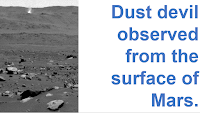The Orionid Meteors are a prolific meteor shower appearing between 2 October and 7 November each year and peaking on the nights of 20-22 October, when the shower can produce 50-70 meteors per hour, originating in the constellation of Orion (above and to the right of Orion's right shoulder). This makes them both one of the more prolific meteor showers, and one of the easiest for an amateur enthusiast to locate the radiant of (apparent point of origin). The peak of this year's display falls on the First Quarter Moon (the Half Moon after a New Moon), which is not ideal for viewing, but better than close to the Full Moon. The best viewing should be just before dawn on Sunday 22 October 2019, from anywhere on Earth.
Meteor streams are thought to come from dust shed by comets as they come close to the Sun and their icy surfaces begin to evaporate away. Although the dust is separated from the comet, it continues to orbit the Sun on roughly the same orbital path, creating a visible meteor shower when the Earth crosses that path, and flecks of dust burn in the upper atmosphere, due to friction with the atmosphere.
The Orionid Meteor Shower is caused by the Earth passing through the trail of Halley's Comet (technically Comet P1/Halley), and encountering dust from the tail of this comet. The dust particles strike the atmosphere at speeds of over 200 000 km per hour, burning up in the upper atmosphere and producing a light show in the process. The Earth does not need to pass close to Halley's Comet for the meteor shower to occur, it simply passes through a trail of dust from the comet's tail that is following the same orbital path. Halley's Comet only visits the Inner Solar System once every 75 years, last doing so in 1986.
Halley's Comet has been observed repeatedly and recognised as the same recurring object since at least 240 BC. However, it takes its modern name from the eighteenth century English Astronomer Edmund Halley, who determined the comet's periodicity in 1705.
Halley's Comet completes one orbit every 75.32 years (27 509 days) on an eccentric, orbit tilted at 162° to the plane of the Solar System (i.e. a retrograde orbit, at an angle of18° to the plane of the Solar System, but travelling in the opposite direction to the majority of the objects in the Solar System), that takes it from 0.56 AU from the Sun (59% of the average distance at which the Earth orbits the Sun, and inside the orbit of the planet Venus) to 35.1 AU from the Sun (35.1 times as far from the Sun as the Earth, and outside the orbit of the planet Neptune). As a comet with a period of more than 20 years but less than 200 years, Halley's Comet is considered to be a Periodic Comet, and a Halley-type Comet.
Halley's Comet was visited by the European Space Agency's Giotto Probe and Russian Vega 1 and Vega 2 probes March 1986, which were able to determine that the nucleus of the comet was only 15 km across, although it was surrounded by a coma about 100 000 km in diameter, made up of fragments of dust and ice released from the surface as it was heated by the Sun, causing the ices on its surface to sublimate (turn directly from solids to gasses), and that this material comprised 80% water, 10% carbon monoxide, 2.5% methane and ammonia, as well as trace amounts of more complex hydrocarbons, iron and sodium.
See also...
Follow Sciency Thoughts on Facebook.
Follow Sciency Thoughts on Twitter.




.jpg)





